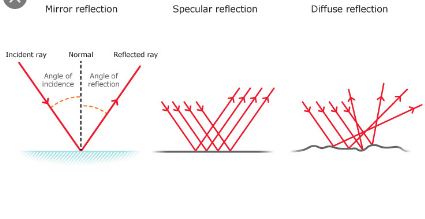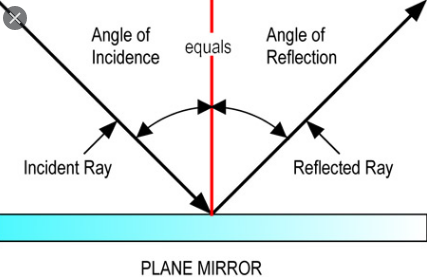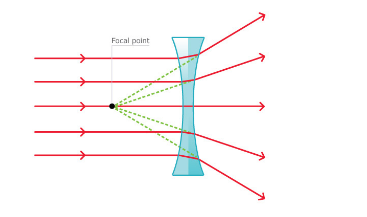Reflection Of Light
Light rays change direction when they reflect off a surface, move from one transparent medium into another or travel through a medium whose composition is continuously changing. Reflection of light is the bouncing back of light when it strikes a smooth surface. If the surface is smooth and shiny like glass, water or polished metal, the light will reflect at the same angle as it hit the surface. Generally there are two forms or types of reflections, that is, Regular reflection (Specular reflection) and Diffused reflection.
Regular or Specular reflection is when light rays hit a smooth surface and travel in the same direction. On the other hand, diffuse reflection is when light hits an object and reflects in lots of different directions. This happens when the surface is rough.

There are two laws in physics that explains behavior of reflection of light. According to the first law of reflection of light, the incident ray, the reflected ray and the normal all lie in the same plane whereas According to the second law of reflection of light (Snell’s law), the angle of reflection is always equal to the angle of incidence.

What You Need To Know About Reflection
- Reflection is the bouncing back of light when it strikes a smooth surface.
- Reflection generally occurs on shinny surfaces that only allow rebounding of light without permitting penetration through it.
- There are generally two forms of reflections, that is, Regular reflection (Specular reflection) and Diffused reflection.
- Reflection generally occurs in mirrors.
- In this process light bounces back and returns back in the same direction.
- When a light ray strikes the boundary of a different medium (shinny surface) the speed of light ray does not vary.
- In reflection, the medium in which light propagates remains the same.
- The angle of reflection and angle of incidence are same in case of reflection.
- According to the first law of reflection of light, the incident ray, the reflected ray and the normal all lie in the same plane.
- According to the second law of reflection of light, the angle of reflection is always equal to the angle of incidence.
Refraction Of Light
Refraction is simply bending or change in direction of light. Refraction occurs as light passes from one medium to another only when there is a difference in the index of refraction (optical density) between two materials. This change of direction is caused by a change in speed. For example, when light travels from air into water, it slows down, causing it to continue to travel at a different angle or direction.
There are two laws of physics that explains behavior of refraction of light. According to the first law of refraction of light, the incident ray, the refracted ray and normal at the point of incidence all lie in the same plane whereas According to the second law of refraction, the ratio of sine of angle of incidence to the sine of angle of refraction is constant for a given pair of media.

The effects of refraction are responsible for a variety of phenomena such as the apparent bending of an object that is partially submerged in water and the mirages observed on a hot, sandy desert. The refraction of visible light is also an important characteristic of lenses that enables them to focus a beam of light onto a single point.
What You Need To Know About Refraction
- Refraction is the bending of light when it travels from one medium to another.
- Refraction occurs in transparent surfaces that allow bending of the ray to a different medium.
- There is a single form of refraction.
- Refraction generally occurs in lenses.
- In this process light changes path i.e travels from one medium to another.
- In the case of refraction, the speed of light varies with the medium in which the ray undergoes bending.
- In refraction, the medium of propagation gets changed.
- The angle of reflection and angle of incidence are not same in refraction.
- According to the first law of refraction of light, the incident ray, the refracted ray and normal at the point of incidence all lie in the same plane.
- According to the second law of refraction, the ratio of sine of angle of incidence to the sine of angle of refraction is constant for a given pair of media.
Also Read: Difference Between Interference And Diffraction Of Light
Difference Between Reflection And Refraction Of Light In Tabular Form
| BASIS OF COMPARISON | REFLECTION | REFRACTION |
| Description | Reflection is the bouncing back of light when it strikes a smooth surface. | Refraction is the bending of light when it travels from one medium to another. |
| Nature Of Surface | Generally occurs on shinny surfaces that only allow rebounding of light without permitting penetration through it. | Occurs in transparent surfaces that allow bending of the ray to a different medium. |
| Types/Forms | There are generally two forms of reflections, that is, Regular reflection (Specular reflection) and Diffused reflection. | There is a single form of refraction. |
| Occurrence | Generally occurs in mirrors. | Generally occurs in lenses. |
| Behavior Of Light | In this process light bounces back and returns back in the same direction. | In this process light changes path i.e travels from one medium to another. |
| Speed Of Light | When a light ray strikes the boundary of a different medium (shinny surface) the speed of light ray does not vary. | The speed of light varies with the medium in which the ray undergoes bending. |
| Medium Of Light Propagation | The medium in which light propagates remains the same. | The medium of propagation gets changed. |
| Angle of Reflection And Angle of Incidence | The angle of reflection and angle of incidence are same in case of reflection. | The angle of reflection and angle of incidence are not same in refraction. |
| First Law | The incident ray, the reflected ray and the normal all lie in the same plane. | The incident ray, the refracted ray and normal at the point of incidence all lie in the same plane. |
| Second Law | The angle of reflection is always equal to the angle of incidence. | The ratio of sine of angle of incidence to the sine of angle of refraction is constant for a given pair of media. |
Also Read: Difference Between Fresnel And Fraunhofer Diffraction
Comments are closed.